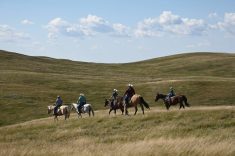I wish the more experienced producers could share with others the little things they do and watch for when checking cattle at calving time.
Watch for problem signs such as bloody discharge from the vagina, or meconium (first feces) in the water bag, indicating the calf is stressed and needs to be extracted.
Some producers keep a respiratory stimulant in the calving kit or have oxygen available to save calves that are born stressed. Now there is another device called a laryngeal masking apparatus, which is regularly used in human medicine. The large human-size unit can be inserted to the back of the throat of the calf and inflated, helping to oxygenate the lungs. With easier calving genetics now we seldom need to pull hard, but occasionally we still run into these highly stressed calves that are running out of time. They simply need oxygen to get them started.
Read Also

Harvest wraps up and fall work begins
At the Eppich famly ranch in western Saskatchewan, the fall harvest was successful with few breakdowns, cows and calves have been sorted and a new tractor has arrived
In the first 24 hours of life the calf can be given its first shots, ear-tagged with dangle and CCIA tags and castrated with rings or rubber bands if it’s a bull calf in a commercial operation.
Many producers have even asked me about giving NSAIDs — a group of medicines that relieve pain and fever and reduce inflammation — at birth since they appear to provide some benefit. There really is no downside to this.
More producers are also giving calves intranasal vaccines as prevention for respiratory disease later in life. There are also a couple of scours vaccines that can be used in the event of an outbreak, but this should not take away from the fact that most producers give scour vaccines to the cows before calving.
Many other producers give toltrazuril for cocci prevention. There is often a debate about whether to give dips, sprays or antimicrobials for prevention of navel infection. It is a good question to ask your veterinarian. Maintaining clean premises also goes a long way to preventing navel infection.
Proper timing at moving
When moving cow-calf pairs, they should go out only if they are ready and mothered up well. Any degree of contracted tendons, small, thin weak calves, or those having a sluggish suckle reflex should be held back. The decision when a pair should join a bigger group is a critical one. Using a good eye to hold the odd pair back to allow for further bonding may actually be a life-or-death decision. Some producers have a smaller pen where these calves can be monitored more closely.
Larger operators have found it useful to keep at least some of the cows that may have lost calves for any reason close by to the calving area in case adoption is necessary. These surrogate mothers can step in to take on a twin, better mother the calf of a very old cow, or nurse a calf if there is a stifle injury.
With a surrogate available a producer can cull the undesirable cow and keep the desirable or young cow in the herd — a win-win situation. With a bit of research and effort, cross-adopting calves with a surrogate can be done.
Keep age groups together
As cow-calf pairs are moved out of the calving area, it is best that the calves stay in their contemporary group of the same ages. For many producers keeping the herd split into 50-60 pairs is ideal. That number is fairly easy to check and if there is some type of disease outbreak it can be confined to one pen, which is a huge advantage. In smaller groups, pairs seem to mother up better and I feel are less stressed.
Ideally, it would be best to keep the pairs near small sheds or creep-type areas were calves can find a warm, dry place away from the cows but still be within eyesight. This also makes it easy to spot ones that are sick and may need treatment.
Just like feedlot cattle, early detection and treatment go a long way to decreasing mortality and preventing such things as chronic infections. Again, a good eye at detection and having your treatment kit with you will improve the prognosis. Supplemental treatments such as a shot of electrolytes or milk replacer may be just what the calf needs to give it a good start on the road back to recovery.
Calves that are really sick may need to be isolated with their mothers, so follow-up treatment can be given and away from other susceptible calves. This may be quite obvious with one with severe scours but other times it is a judgment call. Providing treatment and leaving a sick animal to be quiet in its home pen may be the least stressful option.
I find using a calf catcher hook and good planning allow easy and safe treatment in most cases. Be sure to take temperatures of treated calves as that will tell you a lot.
Make sure to clean and disinfect any equipment to avoid spreading the disease in the herd. In some of the larger operations it is a good practice to have different people calving cows, while others look after the care monitoring the sick calves.
Putting the extra effort into diligent and timely care and treatment leads to more saved calves and fewer cows not raising a calf. And that greatly improves the bottom line at sale time. Here’s to a successful calving season everyone and let’s hope a milder winter is in store for everyone.















